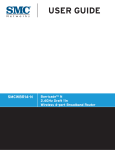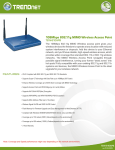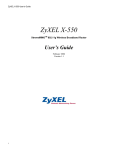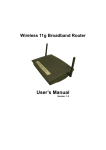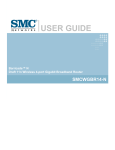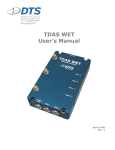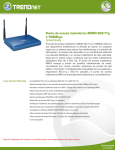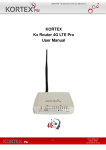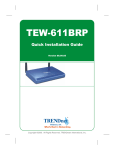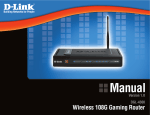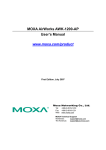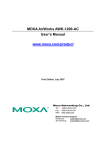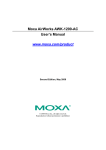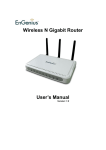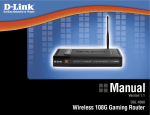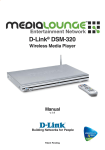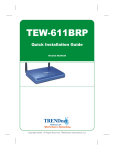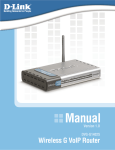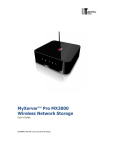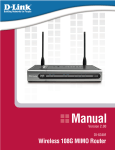Download TRENDnet TEW-611BRP User's Manual
Transcript
1
Federal Communication Commission Interference Statement
This equipment has been tested and found to comply with the limits for a Class B digital device,
pursuant to Part 15 of the FCC Rules. These limits are designed to provide reasonable protection
against harmful interference in a residential installation. This equipment generates, uses and can
radiate radio frequency energy and, if not installed and used in accordance with the instructions, may
cause harmful interference to radio communications.
However, there is no guarantee that
interference will not occur in a particular installation. If this equipment does cause harmful
interference to radio or television reception, which can be determined by turning the equipment off and
on, the user is encouraged to try to correct the interference by one of the following measures:
-
Reorient or relocate the receiving antenna.
Increase the separation between the equipment and receiver.
Connect the equipment into an outlet on a circuit different from that to which the receiver is
connected.
Consult the dealer or an experienced radio/TV technician for help.
FCC Caution: Any changes or modifications not expressly approved by the party responsible for
compliance could void the user's authority to operate this equipment.
This device complies with Part 15 of the FCC Rules. Operation is subject to the following two
conditions: (1) This device may not cause harmful interference, and (2) this device must accept any
interference received, including interference that may cause undesired operation.
Copyright
This publication, including all photographs, illustrations and software, is protected under international
copyright laws, with all rights reserved. Neither this manual, nor any of the material contained herein,
may be reproduced without written consent of the author.
Copyright 2005
Trademark recognition
All product names used in this manual are the properties of their respective owners and are
acknowledged.
2
Table of Contents
Getting Started with the TEW-611BRP ………….....................3
Package Contents ......................................................................4
Minimum System Requirements ................................. …………4
Wireless LAN Networking ........................................................6
Introduction ...............................................................................7
Features ..................................................................................... 7
Hardware Overview ...................................................................8
Rear Panel ……………………………………………………………8
LEDs .........................................................................................9
Installation Considerations ........................................................10
Getting Started ..........................................................................10
Using the Configuration Menu............................................... 11
Basic .......................................................................................12
Advanced ................................................................................25
Tools ..........................................................................................47
Status..........................................................................................58
Glossary ....................................................................................65
3
Getting Started with the TEW-611BRP
Congratulations on purchasing the TEW-611BRP! This manual provides information for setting up and
configuring the TEW-611BRP. This manual is intended for both home users and professionals.
The following conventions are used in this manual:
THE NOTE SYMBOL INDICATES ADDITIONAL INFORMATION ON THE
TOPIC AT HAND.
THE TIP SYMBOL INDICATES HELPFULL INFORMATION AND TIPS TO
IMPROVE YOUR NETWORK EXPERIENCE.
THE CAUTION SYMBOL ALERTS YOU TO SITUATIONS THAT MAY
DEGRADE YOUR NETWORKING EXPERIENCE OR COMPROMISE
LIKE NOTES AND TIPS, THE IMPORTANT SYMBOL INDICATES
INFORMATION THAT CAN IMPROVE NETWORKING. THIS INFORMATION
SHOULD NOT BE OVERLOOKED.
4
Package Contents
z
TEW-611BRP 108Mbps 11g MIMO Wireless Router
z
Power Adapter (5V DC, 2A)
z
CD-ROM with Software and Manual
z
Quick Installation Guide
z
Cat.5 Ethernet Cable
Using a power supply with a different voltage than the one included with your product
will cause damage and void the warranty for this product.
Minimum System Requirements
z
Ethernet-Based Cable or DSL Modem
z
Computers with Windows, Macintosh, or Linux-based operating systems with an installed
Ethernet adapter and CD-ROM Drive
z
Internet Explorer Version 6.0 or Netscape Navigator Version 7.0 and Above
5
Wireless LAN Networking
This section provides background information on wireless LAN networking technology. Consult the
“Glossary” for definitions of the terminology used in this section.
THE INFORMATION IN THIS SECTION IS FOR YOUR REFERENCE. CHANGING NETWORK
SETTINGS AND PARTICULARLY SECURITY SETTTINGS SHOULD ONLY BE DONE BY AN
AUTHORIZED ADMINISTRATOR.
6
Introduction
The TEW-611BRP MIMO Wireless Router is an 802.11g high-performance, wireless router that
supports high-speed wireless networking at home, at work or in public places.
Unlike most routers, the TEW-611BRP provides data transfers at up to 108 Mbps (compared to the
standard 54Mbps) when used with other Super G MIMO products. The 802.11g standard is backwards
compatible with 802.11b products. This means that you do not need to change your entire network to
maintain connectivity. You may sacrifice some of 802.11g’s speed when you mix 802.11b and 802.11g
devices, but you will not lose the ability to communicate when you incorporate the 802.11g standard
into your 802.11b network. You may choose to slowly change your network by gradually replacing the
802.11b devices with 802.11g devices.
Features
¾
¾
¾
¾
¾
¾
¾
¾
¾
¾
¾
¾
¾
¾
¾
¾
Wi-Fi Compliant with IEEE 802.11g and IEEE 802.11b Standards
4 x 10/100Mbps Auto-MDIX LAN Port and 1 x 10/100Mbps WAN Port (Internet)
Supports Cable/DSL Modems with Dynamic IP, Static IP, PPPoE, PPTP, L2TP or BigPong
Connection Types
Supports Super G Technology with Data Rate up to 108Mbps (8X Faster)
Enhance Wireless Coverage up to 800% More Coverage with MIMO Technology
DHCP Server Feature Allocates up to 252 Client IP Addresses and up to 64 Reservations
Supports 64/128-bit WEP(Hex), WPA/WPA2 & WPA-PSK/WPA2-PSK Encryptions
Firewall features Network Address Translation (NAT), and Stateful Packet Inspection (SPI)
protects against Dos attacks
Traffic Control with Virtual Server (max 64 configurable servers) and DMZ
UPnP (Universal Plug & Play) and ALGs Support for Internet applications such as Email, FTP,
Gaming, Remote Desktop, Net Meeting, Telnet, and more
Provides Additional Security of Enable/Disable SSID, Internet Access Control (Services, URL and
MAC Filtering)
Supports Static DHCP Client, Static Routing (RIP v1 Announcer) and Dynamic DNS (8 Verified
Services)
Supports Multiple and Concurrent IPSec, L2TP and PPTP VPN Pass-Through Sessions
Flash Memory for Firmware Upgrade, Save/Restore Settings
Easy Management via Web Browser (HTTP) and Remote Management
Compliant with Windows 95/98/NT/2000/XP/2003 Server, Linux and Mac OS
7
Hardware Overview
Real Panel
DC-IN
The DC power input connector is a single jack socket to supply power to the TEW-611BRP.
Please use the Power Adapter provided on the TEW-611BRP package.
Auto-MDIX LAN Ports
These ports automatically sense the cable type when connecting to Ethernet-enabled computers.
Auto-MDIX WAN Port
This is the connection for the Ethernet cable to the Cable or DSL modem
WLAN Slide Switch
Turn ON/OFF of wireless function.
Reset Button
Pressing the reset button restores the router to its original factory default settings.
8
LEDs
POWER LED
A solid light indicates a proper connection to the power supply.
LAN1~LAN4 LED
A solid light indicates a connection to an Ethernet-enabled computer on ports 1-4. This LED blinks
during data transmission.
WAN LED
A solid light indicates connection on the WAN port. This LED blinks during data transmission.
WLAN LED
A solid light indicates that the wireless segment is ready. This LED blinks during wireless data
transmission.
9
Installation Considerations
The TEW-611BRP MIMO Wireless Router lets you access your network, using a wireless connection,
from virtually anywhere within its operating range. Keep in mind, however, that the number, thickness
and location of walls, ceilings, or other objects that the wireless signals must pass through, may limit
the range. Typical ranges vary depending on the types of materials and background RF (radio
frequency) noise in your home or business. The key to maximizing wireless range is to follow these
basic guidelines:
1
Keep the number of walls and ceilings between the TEW-611BRP and other network devices
to a minimum - each wall or ceiling can reduce your
wireless product’s range from 3-90 feet
(1-30 meters.) Position your devices so that the number of walls or ceilings is minimized.
2
Be aware of the direct line between network devices. A wall that is 1.5 feet thick (.5 meters), at
a 45-degree angle appears to be almost 3 feet (1 meter) thick. At a 2-degree angle it looks
over 42 feet (14 meters) thick! Position devices so that the signal will travel straight through a
wall or ceiling (instead of at an angle) for better reception.
3
Building Materials can impede the wireless signal - a solid metal door or aluminum studs may
have a negative effect on range. Try to position wireless devices and computers with wireless
adapters so that the signal passes through drywall or open doorways and not other materials.
4
Keep your product away (at least 3-6 feet or 1-2 meters) from electrical devices or appliances
that generate extreme RF noise.
Getting Started
For a typical wireless setup at home, please do the following:
1.
2.
3.
4.
You will need broadband Internet access (a Cable or DSL-subscriber line into your home or
office)
Consult with your Cable or DSL provider for proper installation of the modem.
Connect the Cable or DSL modem to the TEW-611BRP Wireless Broadband Router (WAN port).
Ethernet LAN ports of the TEW-611BRP are Auto-MDIX and will work with both Straight-Through
and Cross-Over cable.
10
Using the Configuration Menu
Whenever you want to configure your TEW-611BRP, you can access the Configuration Menu by
opening the Web-browser and typing in the IP Address of the TEW-611BRP. The TEW-611BRP’s
default IP Address is http://192.168.0.1
¾
¾
Open the Web browser.
Type in the IP Address of the Router (http://192.168.0.1).
If you have changed the default IP Address assigned to the TEW-611BRP, make sure to
enter the correct IP Address.
¾
¾
¾
Type admin in the User Name field.
Leave the Password blank.
Click Login In.
11
Basic
The Basic tab provides the following configuration options: Wizard, WAN, LAN, DHCP, and Wireless.
Basic_Wizard
Internet Connection Setup Wizard
This wizard guides you through the following basic router setup steps:
•
Set your Password
•
Select your Time Zone
•
Configure your Internet Connection
12
Wireless Security Setup Wizard
This wizard guides you through the following steps for setting up security for your wireless
network:
•
Name your Wireless Network
•
Secure your Wireless Network
Basic_WAN
The WAN (Wide Area Network) section is where you configure your Internet Connection type. There
are several connection types to choose from: Static IP, DHCP, PPPoE, PPTP, L2TP, and BigPond. If
you are unsure of your connection method, please contact your Internet Service Provider. Note: If
using the PPPoE option, you will need to ensure that any PPPoE client software on your computers is
removed or disabled.
13
Static WAN Mode
Used when your ISP provides you a set IP address that does not change. The IP information is
manually entered in your IP configuration settings. You must enter the IP address, Subnet
Mask, Gateway, Primary DNS Server, and Secondary DNS Server. Your ISP provides you
with all of this information.
DHCP WAN Mode
A method of connection where the ISP assigns your IP address when your router requests one
from the ISP's server. Some ISP's require you to make some settings on your side before your
router can connect to the Internet.
Host Name: Some ISP's may check your computer's Host Name. The Host Name identifies
your system to the ISP's server. This way they know your computer is eligible to receive an IP
address. In other words, they know that you are paying for their service.
Enable BigPond: Check this option to connect to the internet through Telstra BigPond Cable
Broadband in Australia. Telstra BigPond provides the values for BigPond Server, BigPond
User Id, and BigPond Password.
PPPoE
Select this option if your ISP requires you to use a PPPoE (Point to Point Protocol over
Ethernet) connection. DSL providers typically use this option. This method of connection
requires you to enter a Username and Password (provided by your Internet Service Provider)
to gain access to the Internet.
Service Name: Some ISP's may require that you enter a Service Name. Only enter a Service
Name if your ISP requires one.
Reconnect Mode: Typically PPPoE connections are not always on. The Wireless router allows
you to set the reconnection mode. The settings are:
•
Always on: A connection to the Internet is always maintained.
•
On demand: A connection to the Internet is made as needed.
•
Manual: You have to open up the Web-based management interface and click the
Connect button manually any time that you wish to connect to the Internet.
Maximum Idle Time: Time interval the machine can be idle before the PPPoE connection is
disconnected. The Maximum Idle Time value is only used for the "On demand" connection
mode.
PPTP
PPTP (Point to Point Tunneling Protocol) uses a virtual private network to connect to your ISP.
This method of connection is primarily used in Europe. This method of connection requires you
to enter a Username and Password (provided by your Internet Service Provider) to gain
access to the Internet. The ISP provides the values for PPTP IP Address, PPTP Subnet
Mask , PPTP Gateway IP Address, and PPTP Server IP Address (may be the same as the
gateway).
Reconnect Mode: Typically PPTP connections are not always on. The Wireless router allows
you to set the reconnection mode. The settings are:
14
•
Always on: A connection to the Internet is always maintained.
•
On demand: A connection to the Internet is made as needed.
•
Manual: You have to open up the Web-based management interface and click the
Connect button manually any time that you wish to connect to the Internet.
Maximum Idle Time: Time interval the machine can be idle before the PPTP connection is
disconnected. The Maximum Idle Time value is only used for the "On demand" connection
mode.
L2TP
L2TP (Layer Two Tunneling Protocol) uses a virtual private network to connect to your ISP.
This method of connection requires you to enter a Username and Password (provided by
your Internet Service Provider) to gain access to the Internet. The ISP provides the values for
L2TP IP Address, L2TP Subnet Mask, L2TP Gateway IP Address, and L2TP Server IP
Address (may be the same as the gateway).
Reconnect Mode: Typically L2TP connections are not always on. The Wireless router allows
you to set the reconnection mode. The settings are:
•
Always on: A connection to the Internet is always maintained.
•
On demand: A connection to the Internet is made as needed.
•
Manual: You have to open up the Web-based management interface and click the
Connect button manually any time that you wish to connect to the Internet.
Maximum Idle Time: Time interval the machine can be idle before the L2TP connection is
disconnected. The Maximum Idle Time value is only used for the "On demand" connection
mode.
Advanced
These options apply to all WAN modes.
Use These DNS Servers: This option should be enabled if your ISP requires you to enter the
DNS Server information. You will then be able to enter a primary and secondary DNS server.
Use the default MTU: If this option is checked (the default case), the router selects the usual
MTU settings for the type of WAN interface in use. If this option is unchecked, the router uses
the value of the MTU option (which follows).
MTU: The Maximum Transmission Unit (MTU) is a parameter that determines the largest
packet size (in bytes) that the router will send to the WAN. If LAN devices send larger packets,
the router will break them into smaller packets. Ideally, you should set this to match the MTU of
the connection to your ISP. Typical values are 1500 bytes for an Ethernet connection and 1492
bytes for a PPPoE connection. If the router's MTU is set too high, packets will be fragmented
downstream. If the router's MTU is set too low, the router will fragment packets unnecessarily
and in extreme cases may be unable to establish some connections. In either case, network
performance can suffer.
WAN Port Speed: Normally, this is set to "auto". If you have trouble connecting to the WAN, try
the other settings.
Respond to WAN Ping: If you leave this option unchecked, you are causing the public WAN
15
IP address of the router not to respond to ping commands. Pinging public WAN IP addresses
is a common method used by hackers to test whether your WAN IP address is valid.
WAN Ping Inbound Filter: Select a filter that controls access as needed for WAN pings. If you
do not see the filter you need in the list of filters, go to the Advanced -> Inbound Filter screen
and create a new filter.
MAC Cloning Enabled: Some ISP's may check your computer's MAC address. Each
networking device has it's own unique MAC address defined by the hardware manufacturer.
Some ISP's record the MAC address of the network adapter in the computer or router used to
initially connect to their service. The ISP will then only grant Internet access to requests from a
computer or router with this particular MAC address. Your new Wireless router has a different
MAC address than the computer or router that initially connected to the ISP. To resolve this
problem, the Wireless router has a special feature that allows you to clone (that is, replace the
router's MAC address with) another MAC address.
MAC Address: If you have enabled MAC Cloning, you can either type in an alternate MAC
address (for example, the MAC address of the router initially connected to the ISP) or copy the
MAC address of a PC. To copy the MAC address of the computer that initially connected to the
ISP, connect to the Wireless router using that computer and click the Clone Your PC's MAC
Address button. The WAN port will then use the MAC address of the network adapter in your
computer.
16
Basic_LAN
These are the settings of the LAN (Local Area Network) interface for the router. The router's local
network (LAN) settings are configured based on the IP Address and Subnet Mask assigned in this
section. The IP address is also used to access this Web-based management interface. It is
recommended that you use the default settings if you do not have an existing network.
IP Address. The IP address of your router on the local area network. Your local area network settings
are based on the address assigned here. For example, 192.168.0.1.
Subnet Mask. The subnet mask of your router on the local area network.
RIP Announcement. Used with multiple routers to broadcast routing information.
Router Metric. The metric or cost of the routes advertised in RIP announcements.
17
Basic_DHCP
DHCP stands for Dynamic Host Configuration Protocol. The DHCP section is where you configure the
built-in DHCP Server to assign IP addresses to the computers and other devices on your local area
network (LAN).
Enable DHCP Server
Once your Wireless router is properly configured and this option is enabled, the DHCP Server
will manage the IP addresses and other network configuration information for computers and
other devices connected to your Local Area Network. There is no need for you to do this
yourself.
The computers (and other devices) connected to your LAN also need to have their TCP/IP
configuration set to "DHCP" or "Obtain an IP address automatically".
When you set Enable DHCP Server, the following options are displayed.
18
DHCP IP Address Range
These two values (from and to) define a range of addresses that the DHCP Server uses when
assigning addresses to computers and devices on your Local Area Network. Any addresses
that are outside of this range are not managed by the DHCP Server; these could, therefore, be
used for manually configured devices or devices that cannot use DHCP to obtain network
address details automatically.
It is possible for a computer or device that is manually configured to have an address that does
reside within this range. In this case the address should be reserved (see Static DHCP Client
below), so that the DHCP Server knows that this specific address can only be used by a
specific computer or device.
Your Wireless router, by default, has a static IP address of 192.168.0.1. This means that
addresses 192.168.0.2 to 192.168.0.254 (from 2 to 254) can be made available for allocation
by the DHCP Server.
Example:
Your Wireless router uses 192.168.0.1 for the IP address. You've assigned a computer that you
want to designate as a Web server with a static IP address of 192.168.0.3. You've assigned
another computer that you want to designate as an FTP server with a static IP address of
192.168.0.4. Therefore the starting IP address for your DHCP IP address range needs to be 5
or greater.
Example:
Suppose you configure the DHCP Server to manage addresses From 100 To 199. This means
that 3 to 99 and 200 to 254 are NOT managed by the DHCP Server. Computers or devices that
use addresses from these ranges are to be manually configured. Suppose you have a web
server computer that has a manually configured address of 192.168.0.100. Because this falls
within the "managed range" be sure to create a reservation for this address and match it to the
relevant computer (see Static DHCP Client below).
DHCP Lease Time
The amount of time that a computer may have an IP address before it is required to renew the
lease. The lease functions just as a lease on an apartment would. The initial lease designates
the amount of time before the lease expires. If the tenant wishes to retain the address when
the lease is expired then a new lease is established. If the lease expires and the address is no
longer needed than another tenant may use the address.
Always Broadcast
If all the computers on the LAN successfully obtain their IP addresses from the router's DHCP
server as expected, this option can remain disabled. However, if one of the computers on the
LAN fails to obtain an IP address from the router's DHCP server, it may have an old DHCP
client that incorrectly turns off the broadcast flag of DHCP packets. Enabling this option will
cause the router to always broadcast its responses to all clients, thereby working around the
problem, at the cost of increased broadcast traffic on the LAN.
Number of Dynamic DHCP Clients
In this section you can see what LAN devices are currently leasing IP addresses.
Revoke: The Revoke option is available for the situation in which the lease table becomes full
19
or nearly full, you need to recover space in the table for new entries, and you know that some
of the currently allocated leases are no longer needed. Clicking Revoke cancels the lease for a
specific LAN device and frees an entry in the lease table. Do this only if the device no longer
needs the leased IP address, because, for example, it has been removed from the network.
Add/Edit Static DHCP Client
This option lets you reserve IP addresses, and assign the same IP address to the network
device with the specified MAC address any time it requests an IP address. This is almost the
same as if a device has a static IP address except that it must still request an IP address from
the Wireless router. The Wireless router will provide the device the same IP address every time.
Static DHCP is helpful for server computers on the local network that are hosting applications
such as Web and FTP. Servers on your network should either use a static IP address or use
this option.
MAC Address: To input the MAC address of your system, enter it in manually or connect to
the Wireless router's Web-Management interface from the system and click the Copy Your
PC's MAC Address button.
A MAC address is usually located on a sticker on the bottom of a network device. The MAC
address is comprised of twelve digits. Each pair of hexadecimal digits are usually separated by
dashes or colons such as 00-0D-88-11-22-33 or 00:0D:88:11:22:33. If your network device is a
computer and the network card is already located inside the computer, you can connect to the
Wireless router from the computer and click the Copy Your PC's MAC Address button to
enter the MAC address.
As an alternative, you can locate a MAC address in a specific operating system by following
the steps below:
Windows 98SE
Windows Me
Windows 2000
Windows XP
Mac OS X
Go to the Start menu, select Run, type in winipcfg, and hit Enter. A popup
window will be displayed. Select the appropriate adapter from the
pull-down menu and you will see the Adapter Address. This is the MAC
address of the device.
Go to your Start menu, select Programs, select Accessories, and select
Command Prompt. At the command prompt type ipconfig /all and hit
Enter. The physical address displayed for the adapter connecting to the
router is the MAC address.
Go to the Apple Menu, select System Preferences, select Network, and
select the Ethernet Adapter connecting to the Wireless router. Select the
Ethernet button and the Ethernet ID will be listed. This is the same as the
MAC address.
Computer Name: You can assign a name for each computer that is given a static IP address.
This may help you keep track of which computers are assigned this way.
Example:
Game Server
Static DHCP Client List
This shows clients that you have specified to have static DHCP address. An entry can be
changed by clicking the Edit icon, or deleted by clicking the Delete icon. When you click the
Edit icon, the item is highlighted, and the "Edit Static DHCP Client" section is activated for
editing.
20
Basic_Wireless
The wireless section is used to configure the wireless settings for your Wireless router. Please note
that changes made on this section may also need to be duplicated on your Wireless Client.
To protect your privacy, use the wireless security mode to configure the wireless security features.
This device supports three wireless security modes including: WEP, WPA-Personal, and
WPA-Enterprise. WEP is the original wireless encryption standard. WPA provides a higher level of
security. WPA-Personal does not require an authentication server. The WPA-Enterprise option does
require a RADIUS authentication server.
Enable Wireless Radio
This option turns off and on the wireless connection feature of the router. When you set this
option, the following parameters are displayed.
21
Wireless Network Name
When you are browsing for available wireless networks, this is the name that will appear in the
list (unless Visibility Status is set to Invisible, see below). This name is also referred to as the
SSID. For security purposes, it is highly recommended to change from the pre-configured
network name.
Visibility Status
The Invisible option allows you to hide your wireless network. When this option is set to Visible,
your wireless network name is broadcast to anyone within the range of your signal. If you're not
using encryption then they could connect to your network. When Invisible mode is enabled,
you must enter the Wireless Network Name (SSID) on the client manually to connect to the
network.
Auto Channel Select
If you select this option, the router automatically finds the channel with least interference and
uses that channel for wireless networking. If you disable this option, the router uses the
channel that you specify with the following Channel option.
Channel
A wireless network uses specific channels in the 2.4GHz wireless spectrum to handle
communication between clients. Some channels in your area may have interference from other
electronic devices. Choose the clearest channel to help optimize the performance and
coverage of your wireless network.
Transmission Rate
By default the fastest possible transmission rate will be selected. You have the option of
selecting the speed if necessary.
802.11 Mode
If all of your devices can connect in 802.11g Mode, you can change the mode to 802.11g only.
If you have some devices that are 802.11b, leave the setting at Mixed.
Super G™ Mode
Super G Turbo Modes must use channel 6 for communication. For Super G with Static Turbo,
802.11g Mode must be set to 802.11g. For proper operation, RTS threshold and
Fragmentation Threshold on the Advanced -> Advanced Wireless screen should both be set to
their default values.
Super G without Turbo: Performance enhancing features such as Packet Bursting, Fast
Frames, and Compression.
Super G with Static Turbo: This mode is not backwards compatible with non-Turbo (legacy)
devices. This mode should only be enabled when all devices on the wireless network are Static
Turbo enabled.
Super G with Dynamic Turbo: This mode is backwards compatible with non-Turbo (legacy)
devices. This mode should be enabled when some devices on the wireless network are not
Turbo enabled but support other Super G features mentioned above.
22
WEP
A method of encrypting data for wireless communication intended to provide the same level of
privacy as a wired network. WEP is not as secure as WPA encryption. To gain access to a
WEP network, you must know the key. The key is a string of characters that you create. When
using WEP, you must determine the level of encryption. The type of encryption determines the
key length. 128-bit encryption requires a longer key than 64-bit encryption. Keys are defined by
entering in a string in HEX (hexadecimal - using characters 0-9, A-F) or ASCII (American
Standard Code for Information Interchange - alphanumeric characters) format. ASCII format is
provided so you can enter a string that is easier to remember. The ASCII string is converted to
HEX for use over the network. Four keys can be defined so that you can change keys easily. A
default key is selected for use on the network.
Example:
64-bit hexadecimal keys are exactly 10 characters in length. (12345678FA is a valid string of
10 characters for 64-bit encryption.)
128-bit hexadecimal keys are exactly 26 characters in length.
(456FBCDF123400122225271730 is a valid string of 26 characters for 128-bit encryption.)
64-bit ASCII keys are up to 5 characters in length (DMODE is a valid string of 5 characters for
64-bit encryption.)
128-bit ASCII keys are up to 13 characters in length (2002HALOSWIN1 is a valid string of 13
characters for 128-bit encryption.)
WPA-Personal and WPA-Enterprise
Both of these options select some variant of Wi-Fi Protected Access (WPA) -- security
standards published by the Wi-Fi Alliance. The WPA Mode further refines the variant that the
router should employ.
WPA Mode: WPA is the older standard; select this option if the clients that will be used with the
router only support the older standard. WPA2 is the newer implementation of the stronger IEEE
802.11i security standard. With the "WPA2" option, the router tries WPA2 first, but falls back to
WPA if the client only supports WPA. With the "WPA2 Only" option, the router associates only
with clients that also support WPA2 security.
Cipher Type: The encryption algorithm used to secure the data communication. TKIP
(Temporal Key Integrity Protocol) provides per-packet key generation and is based on WEP.
AES (Advanced Encryption Standard) is a very secure block based encryption. With the "TKIP
and AES" option, the router negotiates the cipher type with the client, and uses AES when
available.
Group Key Update Interval: The amount of time before the group key used for broadcast and
multicast data is changed.
WPA-Personal
This option uses Wi-Fi Protected Access with a Pre-Shared Key (PSK).
Pre-Shared Key: The key is entered as a pass-phrase of up to 63 alphanumeric characters in
ASCII (American Standard Code for Information Interchange) format at both ends of the
wireless connection. It cannot be shorter than eight characters, although for proper security it
needs to be of ample length and should not be a commonly known phrase. This phrase is used
23
to generate session keys that are unique for each wireless client.
Example:
Wireless Networking technology enables ubiquitous communication
WPA-Enterprise
This option works with a RADIUS Server to authenticate wireless clients. Wireless clients
should have established the necessary credentials before attempting to authenticate to the
Server through this Gateway. Furthermore, it may be necessary to configure the RADIUS
Server to allow this Gateway to authenticate users.
Authentication Timeout: Amount of time before a client will be required to re-authenticate.
RADIUS Server IP Address: The IP address of the authentication server.
RADIUS Server Port: The port number used to connect to the authentication server.
RADIUS Server Shared Secret: A pass-phrase that must match with the authentication
server.
MAC Address Authentication: If this is selected, the user must connect from the same
computer whenever logging into the wireless network.
Advanced:
Optional Backup RADIUS Server
This option enables configuration of an optional second RADIUS server. A second RADIUS
server can be used as backup for the primary RADIUS server. The second RADIUS server is
consulted only when the primary server is not available or not responding. The fields Second
RADIUS Server IP Address, RADIUS Server Port, Second RADIUS server Shared Secret,
Second MAC Address Authentication provide the corresponding parameters for the second
RADIUS Server.
24
Advanced
The Advanced tab provides the following configuration options: Virtual Server, Special Applications,
Gaming, Traffic Shaping, Routing, Access Control, WEB Filter, MAC Address Filter, Firewall, Inbound
Filter, Advanced Wireless and Schedules.
Advanced_Virtual Server
The Virtual Server option gives Internet users access to services on your LAN. This feature is useful
for hosting online services such as FTP, Web, or game servers. For each Virtual Server, you define a
public port on your router for redirection to an internal LAN IP Address and LAN port.
Example:
You are hosting a Web Server on a PC that has LAN IP Address of 192.168.0.50 and your ISP
is blocking Port 80.
1. Name the Virtual Server (for example: Web Server)
2. Enter the IP Address of the machine on your LAN (for example: 192.168.0.50
3. Enter the Private Port as [80]
4. Enter the Public Port as [8888]
25
5. Select the Protocol - TCP
6. Ensure the schedule is set to Always
7. Click Save to add the settings to the Virtual Servers List
8. Repeat these steps for each Virtual Server Rule you wish to add. After the list is
complete, click Save Settings at the top of the page.
With this Virtual Server entry, all Internet traffic on Port 8888 will be redirected to your internal
web server on port 80 at IP Address 192.168.0.50.
Add/Edit Virtual Server
In this section you can add an entry to the Vertual Servers List below or edit an existing entry.
Enable
Entries in the list can be either active (enabled) or inactive (disabled).
Name
Assign a meaningful name to the virtual server, for example Web Server. Several well-known
types of virtual server are available from the "Select Virtual Server" list. Selecting one of these
entries fills some of the remaining parameters with standard values for that type of server.
IP Address
The IP address of the system on your internal network that will provide the virtual service, for
example 192.168.0.50.
Protocol
Select the protocol used by the service.
Private Port
The port that will be used on your internal network.
Public Port
The port that will be accessed from the Internet.
Inbound Filter
Select a filter that controls access as needed for this virtual server. If you do not see the filter
you need in the list of filters, go to the Advanced -> Inbound Filter screen and create a new
filter.
Schedule
Select a schedule for when the service will be enabled. If you do not see the schedule you
need in the list of schedules, go to the Tools -> Schedules screen and create a new schedule.
Save
Saves the new or edited virtual server entry in the following list. When finished updating the
26
virtual server entries, you must still click the Save Settings button at the top of the page to
make the changes effective and permanent.
Virtual Servers List
The section shows the currently defined virtual servers. A Virtual Server can be changed by
clicking the Edit icon, or deleted by clicking the Delete icon. When you click the Edit icon, the
item is highlighted, and the "Edit Virtual Server" section is activated for editing.
Note: You might have trouble accessing a virtual server using its public identity (WAN-side IP-address
of the gateway or its dynamic DNS name) from a machine on the LAN. Your requests may not be
looped back or you may be redirected to the "Forbidden" page.
This will happen if you have an Access Control Rule configured for this LAN machine.
The requests from the LAN machine will not be looped back if Internet access is blocked at the time of
access. To work around this problem, access the LAN machine using its LAN-side identity.
Requests may be redirected to the "Forbidden" page if web access for the LAN machine is restricted
by an Access Control Rule. Add the WAN-side identity (WAN-side IP-address of the router or its
dynamic DNS name) on the Advanced -> Web Filter screen to work around this problem.
Advanced_Special Applications
27
Application Level Gateway (ALG) Configurations
Here you can enable or disable ALGs. Some protocols and applications require special
handling of the IP payload to make them work with network address translation (NAT). Each
ALG provides special handling for a specific protocol or application. A number of ALGs for
common applications are enabled by default.
PPTP
Allows multiple machines on the LAN to connect to their corporate network using PPTP
protocol.
IPSec VPN
Allows multiple VPN clients to connect to their corporate network using IPSec. Some VPN
clients support traversal of IPSec through NAT. This ALG may interfere with the operation of
such VPN clients. If you are having trouble connecting with your corporate network, try turning
this ALG off.
Please check with the system adminstrator of your corporate network whether your VPN client
supports NAT traversal.
RTSP
Allows applications that use Real Time Streaming Protocol to receive streaming media from the
internet. QuickTime and Real Player are some of the common applications using this protocol.
Windows Messenger
Supports use of Microsoft Windows Messenger (the Internet messaging client that ships with
Microsoft Windows) on LAN computers. The SIP ALG must also be enabled when the
Windows Messenger ALG is enabled.
FTP
Allows FTP clients and servers to transfer data across NAT. Refer to the
Advanced -> Virtual Server page if you want to host an FTP server.
NetMeeting
Allows Microsoft NetMeeting clients to communicate across NAT. Note that if you want your
buddies to call you, you should also set up a virtual server for NetMeeting. Refer to the
Advanced -> Virtual Server page for information on how to set up a virtual server.
SIP
Allows devices and applications using VoIP (Voice over IP) to communicate across NAT. Some
VoIP applications and devices have the ability to discover NAT devices and work around them.
This ALG may interfere with the operation of such devices. If you are having trouble making
VoIP calls, try turning this ALG off.
Wake-On-LAN
This feature enables forwarding of "magic packets" (that is, specially formatted wake-up
packets) from the WAN to a LAN computer or other device that is "Wake on LAN" (WOL)
capable. The WOL device must be defined as such on the Advanced -> Virtual Server page.
The LAN IP address for the virtual server is typically set to the broadcast address
28
192.168.0.255. The computer on the LAN whose MAC address is contained in the magic
packet will be awakened.
AOL
Use this ALG if you are experiencing frequent disconnects from the AOL server due to
inactivity.
MMS
Allows Windows Media Player, using MMS protocol, to receive streaming media from the
internet.
L2TP
Allows multiple machines on the LAN to connect to their corporate network using the L2TP
protocol.
Add/Edit Special Applications Rule
The Special Application section is used to open single or multiple ports on your router when the
router senses data sent to the Internet on a "trigger" port or port range. Special Applications
rules apply to all computers on your internal network.
Example:
You need to configure your router to allow a software application running on any computer on
your network to connect to a web-based server or another user on the Internet.
Name
Enter a name for the Special Application Rule, for example Game App, which will help you
identify the rule in the future. You can also select from a list of common applications, and the
remaining configuration values will be filled in accordingly.
Trigger Port Range
Enter the outgoing port range used by your application. [6500-6700]
Trigger Protocol
Select the outbound protocol used by your application. [Both]
Input Port Range
Enter the port range that you want to open up to Internet traffic. [6000-6200]
Input Protocol
Select the protocol used by the Internet traffic coming back into the router through the opened
port range. [Both]
Schedule
Select a schedule for when this rule is in effect. If you do not see the schedule you need in the
list of schedules, go to the Tools -> Schedules screen and create a new schedule.
Save
29
Saves the new or edited Special Applications Rule in the following list. When finished updating
the special applications rules, you must still click the Save Settings button at the top of the
page to make the changes effective and permanent.
With this Special Application Rule enabled, the router will open up a range of ports from
6000-6200 for incoming traffic from the Internet, whenever any computer on the internal
network opens up an application that sends data to the Internet using a port in the range of
6500-6700.
Special Applications Rules List
The section shows the currently defined special applications rules. A special applications rule
can be changed by clicking the Edit icon, or deleted by clicking the Delete icon. When you click
the Edit icon, the item is highlighted, and the "Edit Special Applications Rule" section is
activated for editing.
Advanced_Gaming
Multiple connections are required by some applications, such as internet games, video conferencing,
Internet telephony, and others. These applications have difficulties working through NAT (Network
Address Translation). The Gaming section is used to open multiple ports or a range of ports in your
router and redirect data through those ports to a single PC on your network. This feature allows you to
enter ports in various formats:
Range (50-100)
Individual (80, 68, 888)
Mixed (1020-5000, 689)
30
Edit/Add Game Rule
Here you can add entries to the Game Rules List below, or edit existing entries.
Example:
You are hosting an online game server that is running on a PC with a Private IP Address of
192.168.0.50. This game requires that you open multiple ports (6159-6180, 99) on the router
so Internet users can connect.
Enable
Each entry in Game Rules List can be active (enabled) or inactive (disabled)
Name
Give the Gaming Rule a name that is meaningful to you, for example Game Server. You can
also select from a list of popular games, and many of the remaining configuration values will be
filled in accordingly. However, you should check whether the port values have changed since
this list was created, and you must fill in the IP address field.
IP Address
Enter the local network IP address of the system hosting the game server, for example
192.168.0.50.
TCP Ports To Open / UDP Ports To Open
Enter the TCP ports to open. [6159-6180, 99] / Enter the UDP ports to open. [6159-6180, 99]
Inbound Filter
Select a filter that controls access as needed for this game rule. If you do not see the filter you
need in the list of filters, go to the Advanced -> Inbound Filter screen and create a new filter.
Schedule
Select a schedule for the times when this rule is in effect. If you do not see the schedule you
need in the list of schedules, go to the Tools -> Schedules screen and create a new schedule.
Save
Saves the new or edited Game Rule in the following list. When finished updating the game
rules, you must still click the Save Settings button at the top of the page to make the changes
effective and permanent.
With this Gaming Rule enabled, all TCP and UDP traffic on ports 6159 through 6180 and port
99 is passed through the router and redirected to the Internal Private IP Address of your Game
Server at 192.168.0.50.
Game Rules List
The section shows the currently defined game rules. A game rule can be changed by clicking
the Edit icon, or deleted by clicking the Delete icon. When you click the Edit icon, the item is
highlighted, and the "Edit Game Rule" section is activated for editing.
31
Advanced_Traffic Shaping
The Traffic Shaping™ feature helps improve your network gaming performance by prioritizing
applications. By default, the Traffic Shaping settings are disabled.
32
Traffic Shaping Setup
Enable Traffic Shaping
This option is disabled by default. Enable it for better performance and experience with online
games and other interactive applications, such as VoIP.
Automatic Classification
This option is enabled by default so that your router will automatically determine which
programs should have network priority.
Dynamic Fragmentation
This option should be enabled when you have a slow Internet uplink. It helps to reduce the
impact that large low priority network packets can have on more urgent ones by breaking the
large packets into several smaller packets.
Automatic Uplink Speed
When enabled, this option causes the router to automatically measure the useful uplink
bandwidth each time the WAN interface is re-established (after a reboot, for example).
Measured Uplink Speed
This is the uplink speed measured when the WAN interface was last re-established. The value
may be lower than that reported by your ISP as it does not include all of the network protocol
overheads associated with your ISP's network. Typically, this figure will be between 87% and
91% of the stated uplink speed for xDSL connections and around 5 kbps lower for cable
network connections.
Uplink Speed
If Automatic Uplink Speed is disabled, this options allows you to set the uplink speed manually.
Uplink speed is the speed at which data can be transferred from the router to your ISP. This is
determined by your ISP. ISPs often specify speed as a downlink/uplink pair; for example,
1.5Mbits/284Kbits. For this example, you would enter "284". Alternatively you can test your
uplink speed with a service such as www.dslreports.com. Note however that sites such as DSL
Reports, because they do not consider as many network protocol overheads, will generally
note speeds slightly lower than the Measured Uplink Speed or the ISP rated speed.
Connection Type
By default, the router automatically determines whether the underlying connection is an
xDSL/Frame-relay network or some other connection type (such as cable modem or Ethernet),
and it displays the result as Detected xDSL or Frame Relay Network. If you have an unusual
network connection in which you are actually connected via xDSL but for which you configure
either "Static" or "DHCP" in the WAN settings, setting this option to xDSL or Other Frame
Relay Network ensures that the router will recognize that it needs to shape traffic slightly
differently in order to give the best performance. Choosing xDSL or Other Frame Relay
Network causes the measured uplink speed to be reported slightly lower than before on such
connections, but gives much better results.
Detected xDSL or Frame Relay Network
When Connection Type is set to Auto-detect, the automatically detected connection type is
33
displayed here.
Add/Edit Traffic Shaping Rule
Automatic classification will be adequate for most applications, and specific Traffic Shaping
Rules will not be required. A Traffic Shaping Rule identifies a specific message flow and
assigns a priority to that flow.
Enable
Each entry in Traffic Shaping Rules List can be active (enabled) or inactive (disabled)
Name
Create a name for the rule that is meaningful to you.
Priority
The priority of the message flow is entered here. 0 receives the highest priority (most urgent)
and 255 receives the lowest priority (least urgent).
Protocol
The protocol used by the messages.
Source IP Range
The rule applies to a flow of messages whose LAN-side IP address falls within the range set
here.
Source Port Range
The rule applies to a flow of messages whose LAN-side port number is within the range set
here.
Destination IP Range
The rule applies to a flow of messages whose WAN-side IP address falls within the range set
here.
Destination Port Range
The rule applies to a flow of messages whose WAN-side port number is within the range set
here.
Save
Saves the new or edited Traffic Shaping Rule in the following list. When finished updating the
Traffic Shaping rules, you must still click the Save Settings button at the top of the page to
make the changes effective and permanent.
Traffic Shaping Rules List
The section shows the currently defined Traffic Shaping rules. A Traffic Shaping rule can be
changed by clicking the Edit icon, or deleted by clicking the Delete icon. When you click the
Edit icon, the item is highlighted, and the "Edit Traffic Shaping Rule" section is activated for
editing.
34
Advanced_Routing
Add/Edit Route
Adds a new route to the IP routing table or edits an existing route.
Enable: Specifies whether the entry will be enabled or disabled.
Destination IP: The IP address of packets that will take this route.
Netmask: One bits in the mask specify which bits of the IP address must match.
Gateway: Specifies the next hop to be taken if this route is used. A gateway of 0.0.0.0 implies
there is no next hop, and the IP address matched is directly connected to the router on the
interface specified: LAN or WAN.
Interface: Specifies the interface -- LAN or WAN -- that the IP packet must use to transit out of
the router, when this route is used.
Metric: The relative cost of using this route.
Save: Saves the new or edited route in the following list. When finished updating the routing
table, you must still click the Save Settings button at the top of the page to make the changes
effective and permanent.
Routes List
The section shows the current routing table entries. Certain required routes are predefined and
cannot be changed. Routes that you add can be changed by clicking the Edit icon, or deleted
by clicking the Delete icon. When you click the Edit icon, the item is highlighted, and the "Edit
Route" section is activated for editing.
35
Advanced_Access Control
The Access Control section allows you to control access in and out of devices on your network. Use
this feature as Parental Controls to only grant access to approved sites, limit web access based on
time or dates, and/or block access from applications such as peer-to-peer utilities or games.
Enable
By default, the Access Control feature is disabled. If you need Access Control, check this
option, and you will see the following configuration sections.
Note: Once you enabled the Access Control, you would need to have a rule for all the devices
on the network. For example, every device on the LAN that needs to access the internet must
have an Access Control rule permits it to access the Internet. Device that do not have the rule
cannot access the Internet.
36
Add/Edit Access Control Rule
Access Control Rules specify what a LAN device is allowed to access. Here you can add
entries to the Access Control Rules List or edit existing entries.
Enable
Each entry in Access Control Rules List can be active (enabled) or inactive (disabled)
Policy Name
Create a name for this access control policy (rule) that is meaningful to you. Typically this
would be a system name or user name; for example "Casey's PC".
Address Type
Select the type of address on which you want to base the rule.
IP Address: Enter the IP Address of the machine that you want the access control rule to
apply to. Make sure that the device on the LAN either has a static IP address (that is, one that
is not in the DHCP range) or is in the Static DHCP Client List (see Basic -> DHCP).
Machine Address: Enter the MAC Address of the machine that you want the access control
rule to apply to. If you want to enter the MAC Address of the computer you are using, click the
Copy Your PC's MAC Address button.
Others: If you want to restrict access for all devices that do not have an explicit rule configured
for them, then select "Others" for the Address Type.
Schedule
Select a schedule of the times when you want the policy to apply. If you do not see the
schedule you need in the list of schedules, go to the Tools -> Schedules screen and create a
new schedule.
Apply Web Filter
With this option enabled, the specified system will only have access to the Web sites listed in
the Web Filter section.
Log Internet Access
If this option is enabled, all of the Web sites visited by the specified machine will be logged.
Filter Ports
By clicking the Filter Ports >> button you can specify that the rule prohibits access to specific
IP addresses and ports.
Save
Saves the new or edited access control rule in the following list. Repeat the process, creating
an Access Control Rule for each of the devices on your LAN that needs access to the Internet.
When finished updating the Access Control Rules, you must still click the Save Settings
button at the top of the page to make the changes effective and permanent.
37
Access Control Rules List
This section shows the current access control rules. Rules can be changed by clicking the Edit
icon, or deleted by clicking the Delete icon. When you click the Edit icon, the item is highlighted,
and the "Edit Access Control Rule" section is activated for editing.
Advanced_WEB Filter
The Web Filter section is where you add the Web sites to be used for Access Control.
Add/Edit Web Site
This is where you can add Web sites to the Allowed Web Site List or change entries in the
Allowed Web Site List. The Allowed Web Site List is used for systems that have the Web filter
option enabled in Access Control.
Enable
Entries in the Allowed Web Site List can be activated or deactivated with this checkbox. New
entries are activated by default.
Web Site
Enter the URL (address) of the Web Site that you want to allow; for example: google.com. Do
not enter the http:// preceding the URL. Enter the most inclusive domain; for example, enter
dlink.com and access will be permitted to both www.dlink.com and support.dlink.com.
Note: Many web sites construct pages with images and content from other web sites. Access
will be forbidden if you do not enable all the web sites used to construct a page. For example,
to access my.yahoo.com, you need to enable access to yahoo.com, yimg.com, and
38
doubleclick.net.
Save
Saves the new or edited Allowed Web Site in the following list. When finished updating the
Allowed Web Site List, you must still click the Save Settings button at the top of the page to
make the changes effective and permanent.
Allowed Web Site List
The section lists the currently allowed web sites. An allowed web site can be changed by
clicking the Edit icon, or deleted by clicking the Delete icon. When you click the Edit icon, the
item is highlighted, and the "Edit Web Site" section is activated for editing.
Advanced_MAC Address Filter
The MAC address filter section can be used to filter network access by machines based on the unique
MAC addresses of their network adapter(s). It is most useful to prevent unauthorized wireless devices
from connecting to your network. A MAC address is a unique ID assigned by the manufacturer of the
network adapter.
Enable MAC Address Filter
When this is enabled, computers are granted or denied network access depending on the
mode of the filter.
39
Note: Misconfiguration of this feature can prevent any machine from accessing the network. In
such a situation, you can regain access by activating the factory defaults button on the router
itself.
Filter Settings
Mode
When "only allow listed machines" is selected, only computers with MAC addresses listed in
the MAC Address List are granted network access. When "only deny listed machines" is
selected, any computer with a MAC address listed in the MAC Address List is refused access
to the network.
Filter Wireless Clients
When this is selected, the MAC address filters will be applied to wireless network clients.
Filter Wired Clients
When this is selected, the MAC address filters will be applied to wired network clients.
Add/Edit MAC Address
In this section, you can add entries to the MAC Address List below, or edit existing entries.
Enable
MAC address entries can be activated or deactivated with this checkbox.
MAC Address
Enter the MAC address of the desired computer or connect to the router from the desired
computer and click the Copy your PC’s MAC Address button.
Save
Saves the new or edited MAC Address entry in the following list. When finished updating the
MAC Address List, you must still click the Save Settings button at the top of the page to make
the changes effective and permanent.
MAC Address List
The section lists the current MAC Address filters. A MAC Address entry can be changed by
clicking the Edit icon, or deleted by clicking the Delete icon. When you click the Edit icon, the
item is highlighted, and the "Edit MAC Address" section is activated for editing.
40
Advanced_Firewall
Enable SPI
SPI ("stateful packet inspection" also known as "dynamic packet filtering") helps to prevent
cyberattacks by tracking more state per session. It validates that the traffic passing through
that session conforms to the protocol. When SPI is enabled, the extra state information will be
reported on the Status -> Active Sessions page.
Enable DMZ
DMZ means "Demilitarized Zone." If an application has trouble working from behind the router,
you can expose one computer to the Internet and run the application on that computer.
Note: Putting a computer in the DMZ may expose that computer to a variety of security risks.
Use of this option is only recommended as a last resort.
DMZ IP Address
Specify the IP address of the computer on the LAN that you want to have unrestricted Internet
communication. If this computer obtains its address Automatically using DHCP, then you may
want to make a static reservation on the Basic -> DHCP page so that the IP address of the
DMZ machine does not change.
41
Advanced_Inbound Filter
The Inbound Filter option is an advanced method of controlling data received from the Internet. With
this feature you can configure inbound data filtering rules that control data based on IP Address.
Inbound Filters can be used for limiting access to a server on your network to a system or group of
systems. Filter rules can be used with Virtual Server, Gaming, or Remote Administration features.
Each filter can be used for several functions; for example a "Game Clan" filter might allow all of the
members of a particular gaming group to play several different games for which gaming entries have
been created. At the same time an "Admin" filter might only allows systems from your office network
to access the WAN admin pages and an FTP server you use at home. If you add an IP address to a
filter, the change is effected in all of the places where the filter is used.
Add/Edit Inbound Filter Rule
Here you can add entries to the Inbound Filter Rules List below, or edit existing entries.
Name
Enter a name for the rule that is meaningful to you.
Action
The rule can either Allow or Deny messages.
42
Source IP Range
Define the ranges of Internet addresses this rule applies to. For a single IP address, enter the
same address in both the Start and End boxes. Up to eight ranges can be entered. The
Enable checkbox allows you to turn on or off specific entries in the list of ranges.
Save
Saves the new or edited Inbound Filter Rule in the following list. When finished updating the
Inbound Filter Rules List, you must still click the button at the top of the page to make the
changes effective and permanent.
Inbound Filter Rules List
The section lists the current Inbound Filter Rules. An Inbound Filter Rule can be changed by
clicking the Edit icon, or deleted by clicking the Delete icon. When you click the Edit icon, the
item is highlighted, and the "Edit Inbound Filter Rule" section is activated for editing.
In addition to the filters listed here, two predefined filters are available wherever inbound filters
can be applied:
Allow All
Permit any WAN user to access the related capability.
Deny All
Prevent all WAN users from accessing the related capability. (LAN users are not affected by
Inbound Filter Rules.)
Advanced_Advanced Wireless
43
Fragmentation Threshold
This setting should remain at its default value of 2346. Setting the Fragmentation value too low
may result in poor performance.
RTS Threshold
This setting should remain at its default value of 2346. If you encounter inconsistent data flow,
only minor modifications to the value are recommended.
Beacon Period
Beacons are packets sent by a wireless router to synchronize wireless devices. Specify a
Beacon Period value between 20 and 1000. The default value is set to 100 milliseconds.
DTIM Interval
A DTIM is a countdown informing clients of the next window for listening to broadcast and
multicast messages. When the wireless router has buffered broadcast or multicast messages
for associated clients, it sends the next DTIM with a DTIM Interval value. Wireless clients
detect the beacons and awaken to receive the broadcast and multicast messages. The default
value is 1. Valid settings are between 1 and 255.
802.11d Enable
Enables 802.11d operation. 802.11d is a wireless specification for operation in additional
regulatory domains. This supplement to the 802.11 specifications defines the physical layer
requirements (channelization, hopping patterns, new values for current MIB attributes, and
other requirements to extend the operation of 802.11 WLANs to new regulatory domains
(countries). The current 802.11 standard defines operation in only a few regulatory domains
(countries). This supplement adds the requirements and definitions necessary to allow 802.11
WLAN equipment to operate in markets not served by the current standard. Enable this option
if you are operating in one of these "additional regulatory domains".
Transmit Power
Normally the wireless transmitter operates at 100% power. In some circumstances, however,
there might be a need to isolate specific frequencies to a smaller area. By reducing the power
of the radio, you can prevent transmissions from reaching beyond your corporate/home office
or designated wireless area.
WDS Enable
When WDS is enabled, this access point functions as a wireless repeater and is able to
wirelessly communicate with other APs via WDS links. Note that WDS is incompatible with
WPA -- both features cannot be used at the same time. A WDS link is bidirectional; so this AP
must know the MAC Address (creates the WDS link) of the other AP, and the other AP must
have a WDS link back to this AP.
WDS AP MAC Address
Specifies one-half of the WDS link. The other AP must also have the MAC address of this AP
to create the WDS link back to this AP.
44
Advanced_Schedules
Schedules can be created for use with enforcing rules. For example, if you want to restrict web access
to Mon-Fri from 3pm to 8pm, you could create a schedule selecting Mon, Tue, Wed, Thu, and Fri and
enter a Start Time of 3pm and End Time of 8pm.
Add/Edit Schedule Rule
In this section you can add entries to the Schedule Rules List below or edit existing entries.
Name
Give the schedule a name that is meaningful to you, such as "Weekday rule".
Day(s)
Place a checkmark in the boxes for the desired days or select the All Week radio button to
select all seven days of the week.
All Day - 24 hrs
Select this option if you want this schedule in effect all day for the selected day(s).
Start Time
If you don't use the All Day option, then you enter the time here. The start time is entered in
two fields. The first box is for the hour and the second box is for the minute. Email events are
triggered only by the start time.
45
End Time
The end time is entered in the same format as the start time. The hour in the first box and the
minutes in the second box. The end time is used for most other rules, but is not used for email
events.
Save
Saves the new or edited Schedule Rule in the following list. When finished updating the
Schedule Rules, you must still click the button at the top of the page to make the changes
effective and permanent.
Schedule Rules List
The section shows the currently defined Schedule Rules. A Schedule Rule can be changed by
clicking the Edit icon, or deleted by clicking the Delete icon. When you click the Edit icon, the
item is highlighted, and the "Edit Schedule Rule" section is activated for editing.
46
Tools
The Tools tab provides the following configuration options: Admin, Time, Syslog, Email, System,
Firmware and Dynamic DNS.
Tools_Admin
The Admin option is used to set a password for access to the Web-based management. By default
there is no password configured. It is highly recommended that you create a password to keep your
new router secure.
47
Admin Password
Enter a password for the user "admin", who will have full access to the Web-based
management interface.
User Password
Enter a password for the user "user", who will have read-only access to the Web-based
management interface.
Router Name
The name of the router can be changed here.
Enable Remote Management
Enabling Remote Management allows you to manage the router from anywhere on the Internet.
Disabling Remote Management allows you to manage the router only from computers on your
LAN.
Remote Admin Port
The port that you will use to address the management interface from the Internet. For example,
if you specify port 1080 here, then, to access the router from the Internet, you would use a URL
of the form: http://my.domain.com:1080/.
Remote Admin Inbound Filter
Select a filter that controls access as needed for this admin port. If you do not see the filter you
need in the list of filters, go to the Advanced -> Inbound Filter screen and create a new filter.
Admin Idle Timeout
The amount of time before the administration session (either remote or local) is closed when
there is no activity.
Save Configuration
This option allows you to save the router's configuration to a file on your computer. Be sure to
save the configuration before performing a firmware upgrade.
Restore Configuration from File
Use this option to load previously saved router configuration settings.
Save Configuration To Wireless Network Setup Wizard
If your PC's operating system is Windows XP Service Pack 2 (SP2) or later and you are using
Windows Internet Explorer (IE) as your browser, you can use this option to save key parts of
the router's current wireless security settings to your PC with Windows Connect Now (WCN)
technology. The settings will then be available to propagate to other wireless devices.
WCN ActiveX Control
The WCN ActiveX Control provides the necessary WCN link between the router and your PC
via the browser. The browser will attempt to download the WCN ActiveX Control, if it is not
already available on your PC. For this action to succeed, the WAN connection must be
established, and the browser's internet security setting must be Medium or lower (select Tools
48
-> Internet Options -> Security -> Custom Level -> Medium).
Click the Save to Windows Connect Now button, and the WCN technology will capture the
wireless network settings from your router and save them on your PC.
Note that WCN only saves a few of the wireless security settings. When you use WCN to
propagate settings to other wireless devices, you may have to make additional settings
manually on those devices.
Note that, in Microsoft's current implementation of WCN, you cannot save the wireless settings
if a profile of the same name already exists. To work around this limitation, either delete the
existing profile or change the SSID when you change the wireless settings; then, when you
save the new settings, a new profile will be created.
Tools_Time
The Time Configuration option allows you to configure, update, and maintain the correct time on the
router's internal system clock. From this section you can set the time zone that you are in and set the
Time Server. Daylight saving can also be configured to automatically adjust the time when needed.
49
Time Configuration
Time Zone
Select your local time zone from pull down menu.
Daylight Saving Enable
Check this option if your location observes daylight saving time.
Daylight Saving Offset
Select the time offset, if your location observes daylight saving time.
DST Start and DST End
Select the starting and ending times for the change to and from daylight saving time. For
example, suppose for DST Start you select Month="Oct", Week="3rd", Day="Sun" and
Time="2am". This is the same as saying: "Daylight saving starts on the third Sunday of
October at 2:00 AM."
Automatic Time Configuration
Enable NTP Server
Select this option if you want the router's clock synchronized to a Network Time Server over
the Internet. If you are using schedules or logs, this is the best way to ensure that the
schedules and logs are kept accurate.
NTP Server
Select a Network Time Server for synchronization. You can type in the address of a time
server or select one from the list. If you have trouble using one server, select another.
Set the Date and Time Manually
If you do not have the NTP Server option in effect, you can either manually set the time for
your router here, or you can click the Copy Your Computer's Time Settings button to copy
the time from the computer you are using. (Make sure that computer's time is set correctly.)
Note: If the router loses power for any reason, it cannot keep its clock running, and will not have the
correct time when it is started again. To maintain correct time for schedules and logs, either you must
enter the correct time after you restart the router, or you must enable the NTP Server option.
50
Tools_Syslog
This section allows you to archive your log files to a Syslog Server.
Enable Logging to Syslog Server
Enable this option if you have a syslog server currently running on the LAN and wish to send
log messages to it. Enabling this option causes the following parameter to be displayed.
Syslog Server IP Address
Enter the LAN IP address of the Syslog Server.
51
Tools_Email
The Email feature can be used to send the system log files, router alert messages, and firmware
update notification to your email address.
Enable
Enable Email Notification
When this option is enabled, router activity logs or firmware upgrade notifications can be
emailed to a designated email address, and the following parameters are displayed.
Email Settings
From Email Address
This email address will appear as the sender when you receive a log file or firmware upgrade
notification via email.
To Email Address
Enter the email address where you want the email sent.
52
SMTP Server Address
Enter the SMTP server address for sending email.
Enable Authentication
If your SMTP server requires authentication, select this option.
Account Name
Enter your account for sending email.
Password
Enter the password associated with the account.
Verify Password
Re-type the password associated with the account.
Email Log When Full or on Schedule
On Log Full
Select this option if you want logs to be sent by email when the log is full.
Schedule
Select this option if you want logs to be sent by email according to a schedule.
Select Schedule
If you selected the Schedule option, select one of the defined schedule rules. If you do not see
the schedule you need in the list of schedules, go to the Tools -> Schedules screen and create
a new schedule.
Note: Email is sent at the start time defined for a schedule; the schedule end time is not used
for email.
53
Tools_System
This section allows you to reboot the device, and restore the router to the factory default settings.
Restoring the unit to the factory default settings will erase all settings, including any rules that you've
created.
Reboot the Device
This restarts the router. Useful for restarting when you are not near the device.
Restore all Settings to the Factory Defaults
This option restores all configuration settings back to the settings that were in effect at the time
the router was shipped from the factory. Any settings that have not been saved will be lost. If
you want to save your router configuration settings, you can do so from the Tools -> Admin
page.
Tools_Firmware
The Firmware Upgrade section can be used to update your router to the latest firmware code to
improve functionality and performance.
To upgrade the firmware, follow these steps:
1. Click the Browse button to locate the Wireless upgrade file on your computer.
2. Once you have found the file to be used, click the Upload button below to start the firmware
upgrade process. This can take a minute or more.
3. Wait for the router to reboot. This can take another minute or more.
4. Confirm updated firmware revision on status page.
54
Firmware Information
Here are displayed the version numbers of the firmware currently installed in your router and
the most recent upgrade that is available.
Firmware Upgrade
Note: Firmware upgrade cannot be performed from a wireless device. To perform an upgrade,
ensure that you are using a PC that is connected to the router by wire.
Note: Some firmware upgrades reset the router's configuration options to the factory defaults.
Before performing an upgrade, be sure to save the current configuration from the
Tools -> Admin screen.
Upload
Once you have a firmware update on your computer, use this option to browse for the file and
then upload the information into the router.
55
Tools_Dynamic DNS
The Dynamic DNS feature allows you to host a server (Web, FTP, Game Server, etc.) using a domain
name that you have purchased (www.whateveryournameis.com) with your dynamically assigned IP
address. Most broadband Internet Service Providers assign dynamic (changing) IP addresses. When
you use a Dynamic DNS service provider, your friends can enter your domain name to connect to your
server, no matter what your IP address is.
Enable Dynamic DNS
Enable this option only if you have purchased your own domain name and registered with a
dynamic DNS service provider. The following parameters are displayed when the option is
enabled.
Server Address
Select a dynamic DNS service provider from the pull-down list.
Host Name
Enter your host name.
Username or Key
Enter the username or key provided by your service provider. If the Dynamic DNS provider
supplies only a key, enter that key in all three fields.
56
Password or Key
Enter the password or key provided by your service provider. If the Dynamic DNS provider
supplies only a key, enter that key in all three fields.
Verify Password or Key
Re-type the password or key provided by your service provider. If the Dynamic DNS provider
supplies only a key, enter that key in all three fields.
Timeout
The time between periodic updates to the Dynamic DNS, if your dynamic IP address has not
changed. The timeout period is entered in hours.
Note: After configuring the router for dynamic DNS, you can open a browser and navigate to the URL
for your domain (for example http://www.mydomain.info) and the router will attempt to forward the
request to port 80 on your LAN. If, however, you do this from a LAN-side computer and there is no
virtual server defined for port 80, the router will return the router's configuration home page. Refer to
the Advanced -> Virtual Server configuration page to set up a a virtual server.
57
Status
The Status tab provides the following configuration options: Device Info, Wireless, Routing, Logs,
Statistics and Active Sessions.
Status_Device info
All of your Internet and network connection details are displayed on the Device Info page. The
firmware version is also displayed here.
Some browsers have limitations that make it impossible to update the WAN status display
when the status changes. Some browsers require that you refresh the display to obtain
updated status. Some browsers report an error condition when trying to obtain WAN status.
58
DHCP Connection
Click the DHCP Release button to release the router's IP address. The router will not respond
to IP messages from the WAN side until you click the DHCP Renew button or power-up the
router again. Clicking the DHCP Renew button causes the router to request a new IP address
from the ISP's server.
PPPoE, PPTP, L2TP Connection
Depending on whether the WAN connection is currently established, you can click either the
DHCP Renew to attempt to establish the WAN connection or the DHCP Release to break the
WAN connection.
BigPond Connection
Depending on whether you are currently logged in to BigPond, you can click either the DHCP
Renew to attempt to establish the WAN connection or the DHCP Release to break the WAN
connection.
Status_Wireless
The wireless section allows you to view the wireless clients that are connected to your
wireless router.
MAC Address
The Ethernet ID (MAC address) of the wireless client.
IP Address
The LAN-side IP address of the client.
Mode
The transmission standard being used by the client. Values are 11a, 11b, or 11g for 802.11a,
802.11b, or 802.11g respectively.
Rate
The actual transmission rate of the client in megabits per second.
59
Signal
This is a relative measure of signal quality. The value is expressed as a percentage of
theoretical best quality. Signal quality can be reduced by distance, by interference from other
radio-frequency sources (such as cordless telephones or neighboring wireless networks), and
by obstacles between the router and the wireless device.
Status_Routing
The routing section displays all of the routing details configured for your router.
A value of 0.0.0.0 for gateway means there is no next hop, and the IP address is directly connected to
the router on the interface specified: LAN or WAN. A value of 0.0.0.0 in both the destination IP and net
mask means that this is the default route.
60
Status_Logs
The router automatically logs (records) events of possible interest in its internal memory. If there is not
enough internal memory for all events, logs of older events are deleted, but logs of the latest events
are retained. The Logs option allows you to view the router logs. You can define what types of events
you want to view and the level of events to view. This router also has external Syslog Server support
so you can send the log files to a computer on your network that is running a Syslog utility.
What to View
Select the kinds of events that you want to view.
•
Firewall and Security
•
System
•
Router Status
View Levels
Select the level of events that you want to view.
•
Critical
•
Warning
•
Informational
61
Apply Log Settings Now
Click this button after changing Log Options to make them effective and permanent.
Refresh
Clicking this button refreshes the display of log entries. There may be new events since the last
time you accessed the log.
Clear
Clicking this button erases all log entries.
Email Now
If you provided email information with the Tools -> Email screen, clicking the Email Now button
sends the router log to the configured email address.
Save Log
Select this option to save the router log to a file on you computer.
Status_Statistics
The Statistics page displays all of the LAN, WAN, and Wireless packet transmit and receive statistics.
62
Sent
The number of packets sent from the router.
Received
The number of packets received by the router.
TX Packets Dropped
The number of packets that were dropped while being sent, due to errors, collisions, or router
resource limitations.
RX Packets Dropped
The number of packets that were dropped while being received, due to errors, collisions, or
router resource limitations.
Collisions
The number of packets that were dropped due to Ethernet collisions (two or more devices
attempting to use an Ethernet circuit at the same time).
Errors
The number of transmission failures that cause loss of a packet. A noisy radio-frequency
environment can cause a high error rate on the wireless LAN.
Status_Active Sessions
The Active Sessions page displays full details of active sessions through your router. A session is a
conversation between a progam or application on a LAN-side computer and a program or application
on a WAN-side computer.
Internal
The IP address and port number of the LAN-side application.
63
Protocol
The communications protocol used for the conversation.
External
The IP address and port number of the WAN-side application.
NAT
The port number of the LAN-side application as viewed by the WAN-side application.
Priority
The preference given to outbound packets of this conversation by the Traffic Shaping logic.
Smaller numbers represent higher priority.
State
When SPI (Stateful Packet Inspection) is enabled, this is the state for sessions that use the
TCP protocol.
Dir
The direction of initiation of the conversation:
Egress
Initiated from LAN to WAN.
Ingress
Initiated from WAN to LAN.
Time Out
The number of seconds of idle time until the router considers the session terminated.
64
Glossary
A
Access Control List
ACL. This is a database of network devices that are allowed to access resources on the
network.
Access Point
AP. Device that allows wireless clients to connect to it and access the network
ActiveX
A Microsoft specification for the interaction of software components.
Ad-hoc network
Peer-to-Peer network between wireless clients
Address Resolution Protocol
ARP. Used to map MAC addresses to IP addresses so that conversions can be made in both
directions.
ADSL
Asymmetric Digital Subscriber Line
Advanced Encryption Standard
AES. Government encryption standard
Alphanumeric
Characters A-Z and 0-9
Antenna
Used to transmit and receive RF signals.
AppleTalk
A set of Local Area Network protocols developed by Apple for their computer systems
AppleTalk Address Resolution Protocol
AARP. Used to map the MAC addresses of Apple computers to their AppleTalk network
addresses, so that conversions can be made in both directions.
Application layer
7th Layer of the OSI model. Provides services to applications to ensure that they can
communicate properly with other applications on a network.
ASCII
65
American Standard Code for Information Interchange. This system of characters is most
commonly used for text files
Attenuation
The loss in strength of digital and analog signals. The loss is greater when the signal is being
transmitted over long distances.
Authentication
To provide credentials, like a Password, in order to verify that the person or device is really
who they are claiming to be
Automatic Private IP Addressing
APIPA. An IP address that that a Windows computer will assign itself when it is configured to
obtain an IP address automatically but no DHCP server is available on the network
B
Backward Compatible
The ability for new devices to communicate and interact with older legacy devices to guarantee
interoperability
Bandwidth
The maximum amount of bytes or bits per second that can be transmitted to and from a
network device
Basic Input/Output System
BIOS. A program that the processor of a computer uses to startup the system once it is turned
on
Baud
Data transmission speed
Beacon
A data frame by which one of the stations in a Wi-Fi network periodically broadcasts network
control data to other wireless stations.
Bit rate
The amount of bits that pass in given amount of time
Bit/sec
Bits per second
BOOTP
Bootstrap Protocol. Allows for computers to be booted up and given an IP address with no user
intervention
Bottleneck
66
A time during processes when something causes the process to slowdown or stop all together
Broadband
A wide band of frequencies available for transmitting data
Broadcast
Transmitting data in all directions at once
Browser
A program that allows you to access resources on the web and provides them to you
graphically
C
Cable modem
A device that allows you to connect a computer up to a coaxial cable and receive Internet
access from your Cable provider
CardBus
A newer version of the PC Card or PCMCIA interface. It supports a 32-bit data path, DMA, and
consumes less voltage
CAT 5
Category 5. Used for 10/100 Mbps or 1Gbps Ethernet connections
Client
A program or user that requests data from a server
Collision
When do two devices on the same Ethernet network try and transmit data at the exact same
time.
Cookie
Information that is stored on the hard drive of your computer that holds your preferences to the
site that gave your computer the cookie
D
Data
Information that has been translated into binary so that it can be processed or moved to
another device
Data Encryption Standard
Uses a randomly selected 56-bit key that must be known by both the sender and the receiver
when information is exchanged
Data-Link layer
67
The second layer of the OSI model. Controls the movement of data on the physical link of a
network
Database
Organizes information so that it can be managed updated, as well as easily accessed by users
or applications.
DB-25
A 25 ping male connector for attaching External modems or RS-232 serial devices
DB-9
A 9 pin connector for RS-232 connections
dBd
Decibels related to dipole antenna
dBi
Decibels relative to isotropic radiator
dBm
Decibels relative to one milliwatt
Decrypt
To unscramble an encrypted message back into plain text
Default
A predetermined value or setting that is used by a program when no user input has been
entered for this value or setting
Demilitarized zone
DMZ: A single computer or group of computers that can be accessed by both users on the
Internet as well as users on the Local Network, but that is not protected by the same security
as the Local Network.
DHCP
Dynamic Host Configuration Protocol: Used to automatically assign IP addresses from a
predefined pool of addresses to computers or devices that request them
Digital certificate:
An electronic method of providing credentials to a server in order to have access to it or a
network
Direct Sequence Spread Spectrum
DSSS: Modulation technique used by 802.11b wireless devices
DMZ
68
"Demilitarized Zone". A computer that logically sits in a "no-mans land" between the LAN and
the WAN. The DMZ computer trades some of the protection of the router's security
mechanisms for the convenience of being directly addressable from the Internet.
DNS
Domain Name System: Translates Domain Names to IP addresses
Domain name
A name that is associated with an IP address
Download
To send a request from one computer to another and have the file transmitted back to the
requesting computer
DSL
Digital Subscriber Line. High bandwidth Internet connection over telephone lines
Duplex
Sending and Receiving data transmissions at the sane time
Dynamic DNS service
Dynamic DNS is provided by companies to allow users with Dynamic IP addresses to obtain a
Domain Name that will always by linked to their changing IP address. The IP address is
updated by either client software running on a computer or by a router that supports Dynamic
DNS, whenever the IP address changes
Dynamic IP address
IP address that is assigned by a DHCP server and that may change. Cable Internet providers
usually use this method to assign IP addresses to their customers.
E
EAP
Extensible Authentication Protocol
Email
Electronic Mail is a computer-stored message that is transmitted over the Internet
Encryption
Converting data into cyphertext so that it cannot be easily read
Ethernet
The most widely used technology for Local Area Networks.
F
Fiber optic
69
A way of sending data through light impulses over glass or plastic wire or fiber
File server
A computer on a network that stores data so that the other computers on the network can all
access it
File sharing
Allowing data from computers on a network to be accessed by other computers on the network
with different levels of access rights
Firewall
A device that protects resources of the Local Area Network from unauthorized users outside of
the local network
Firmware
Programming that is inserted into a hardware device that tells it how to function
Fragmentation
Breaking up data into smaller pieces to make it easier to store
FTP
File Transfer Protocol. Easiest way to transfer files between computers on the Internet
Full-duplex
Sending and Receiving data at the same time
G
Gain
The amount an amplifier boosts the wireless signal
Gateway
A device that connects your network to another, like the internet
Gbps
Gigabits per second
Gigabit Ethernet
Transmission technology that provides a data rate of 1 billion bits per second
GUI
Graphical user interface
H
H.323
70
A standard that provides consistency of voice and video transmissions and compatibility for
videoconferencing devices
Half-duplex
Data cannot be transmitted and received at the same time
Hashing
Transforming a string of characters into a shorter string with a predefined length
Hexadecimal
Characters 0-9 and A-F
Hop
The action of data packets being transmitted from one router to another
Host
Computer on a network
HTTP
Hypertext Transfer Protocol is used to transfer files from HTTP servers (web servers) to HTTP
clients (web browsers)
HTTPS
HTTP over SSL is used to encrypt and decrypt HTTP transmissions
Hub
A networking device that connects multiple devices together
I
ICMP
Internet Control Message Protocol
IEEE
Institute of Electrical and Electronics Engineers
IGMP
Internet Group Management Protocol is used to make sure that computers can report their
multicast group membership to adjacent routers
IIS
Internet Information Server is a WEB server and FTP server provided by Microsoft
IKE
Internet Key Exchange is used to ensure security for VPN connections
71
Infrastructure
In terms of a wireless network, this is when wireless clients use an Access Point to gain access
to the network
Internet
A system of worldwide networks which use TCP/IP to allow for resources to be accessed from
computers around the world
Internet Explorer
A World Wide Web browser created and provided by Microsoft
Internet Protocol
The method of transferring data from one computer to another on the Internet
Internet Protocol Security
IPsec provides security at the packet processing layer of network communication
Internet Service Provider
An ISP provides access to the Internet to individuals or companies
Intranet
A private network
Intrusion Detection
A type of security that scans a network to detect attacks coming from inside and outside of the
network
IP
Internet Protocol
IP address
A 32-bit number, when talking about Internet Protocol Version 4, that identifies each computer
that transmits data on the Internet or on an Intranet
IPsec
Internet Protocol Security
IPX
Internetwork Packet Exchange is a networking protocol developed by Novel to enable their
Netware clients and servers to communicate
ISP
Internet Service Provider
J
72
Java
A programming language used to create programs and applets for web pages
K
Kbps
Kilobits per second
Kbyte
Kilobyte
L
LAN
Local Area Network
Latency
The amount of time that it takes a packet to get from the one point to another on a network.
Also referred to as delay
LED
Light Emitting Diode
Legacy
Older devices or technology
Local Area Network
A group of computers in a building that usually access files from a server
LPR/LPD
"Line Printer Requestor"/"Line Printer Daemon". A TCP/IP protocol for transmitting streams of
printer data.
L2TP
Layer 2 Tunneling Protocol
M
MAC address
A unique hardware ID assigned to every Ethernet adapter by the manufacturer.
Mbps
Megabits per second
MDI
Medium Dependent Interface is an Ethernet port for a connection to a straight-through cable
73
MDIX
Medium Dependent Interface Crossover, is an Ethernet port for a connection to a crossover
cable
MIB
Management Information Base is a set of objects that can be managed by using SNMP
Modem
A device that Modulates digital signals from a computer to an analog signal in order to transmit
the signal over phone lines. It also Demodulates the analog signals coming from the phone
lines to digital signals for your computer
MPPE
Microsoft Point-to-Point Encryption is used to secure data transmissions over PPTP
connections
MTU
Maximum Transmission Unit is the largest packet that can be transmitted on a packet-based
network like the Internet
Multicast
Sending data from one device to many devices on a network
N
NAT
Network Address Translation allows many private IP addresses to connect to the Internet, or
another network, through one IP address
NetBEUI
NetBIOS Extended User Interface is a Local Area Network communication protocol. This is an
updated version of NetBIOS
NetBIOS
Network Basic Input/Output System
Netmask
Determines what portion of an IP address designates the Network and which part designates
the Host
Network Interface Card
A card installed in a computer or built onto the motherboard that allows the computer to
connect to a network
Network Layer
The third layer of the OSI model which handles the routing of traffic on a network
74
Network Time Protocol
Used to synchronize the time of all the computers in a network
NIC
Network Interface Card
NTP
Network Time Protocol
O
OFDM
Orthogonal Frequency-Division Multiplexing is the modulation technique for both 802.11a and
802.11g
OSI
Open Systems Interconnection is the reference model for how data should travel between two
devices on a network
OSPF
Open Shortest Path First is a routing protocol that is used more than RIP in larger scale
networks because only changes to the routing table are sent to all the other routers in the
network as opposed to sending the entire routing table at a regular interval, which is how RIP
functions
P
Password
A sequence of characters that is used to authenticate requests to resources on a network
Personal Area Network
The interconnection of networking devices within a range of 10 meters
Physical layer
The first layer of the OSI model. Provides the hardware means of transmitting electrical signals
on a data carrier
Ping
A utility program that verifies that a given Internet address exists and can receive messages.
The utility sends a control packet to the given address and waits for a response.
PoE
Power over Ethernet is the means of transmitting electricity over the unused pairs in a category
5 Ethernet cable
POP3
Post Office Protocol 3 is used for receiving email
75
Port
A logical channel endpoint in a network. A computer might have only one physical channel (its
Ethernet channel) but can have multiple ports (logical channels) each identified by a number.
PPP
Point-to-Point Protocol is used for two computers to communicate with each over a serial
interface, like a phone line
PPPoE
Point-to-Point Protocol over Ethernet is used to connect multiple computers to a remote server
over Ethernet
PPTP
Point-to-Point Tunneling Protocol is used for creating VPN tunnels over the Internet between
two networks
Preamble
Used to synchronize communication timing between devices on a network
Q
QoS
Quality of Service
R
RADIUS
Remote Authentication Dial-In User Service allows for remote users to dial into a central server
and be authenticated in order to access resources on a network
Reboot
To restart a computer and reload it's operating software or firmware from nonvolatile storage.
Rendezvous
Apple's version of UPnP, which allows for devices on a network to discover each other and be
connected without the need to configure any settings
Repeater
Retransmits the signal of an Access Point in order to extend it's coverage
RIP
Routing Information Protocol is used to synchronize the routing table of all the routers on a
network
RJ-11
The most commonly used connection method for telephones
76
RJ-45
The most commonly used connection method for Ethernet
RS-232C
The interface for serial communication between computers and other related devices
RSA
Algorithm used for encryption and authentication
S
Server
A computer on a network that provides services and resources to other computers on the
network
Session key
An encryption and decryption key that is generated for every communication session between
two computers
Session layer
The fifth layer of the OSI model which coordinates the connection and communication between
applications on both ends
Simple Mail Transfer Protocol
Used for sending and receiving email
Simple Network Management Protocol
Governs the management and monitoring of network devices
SIP
Session Initiation Protocol. A standard protocol for initiating a user session that involves
multimedia content, such as voice or chat.
SMTP
Simple Mail Transfer Protocol
SNMP
Simple Network Management Protocol
SOHO
Small Office/Home Office
SPI
Stateful Packet Inspection
SSH
77
Secure Shell is a command line interface that allows for secure connections to remote
computers
SSID
Service Set Identifier is a name for a wireless network
Stateful inspection
A feature of a firewall that monitors outgoing and incoming traffic to make sure that only valid
responses to outgoing requests are allowed to pass though the firewall
Subnet mask
Determines what portion of an IP address designates the Network and which part designates
the Host
Syslog
System Logger -- a distributed logging interface for collecting in one place the logs from
different sources. Originally written for UNIX, it is now available for other operating systems,
including Windows.
T
TCP
Transmission Control Protocol
TCP/IP
Transmission Control Protocol/Internet Protocol
TCP Raw
A TCP/IP protocol for transmitting streams of printer data.
TFTP
Trivial File Transfer Protocol is a utility used for transferring files that is simpler to use than FTP
but with less features
Throughput
The amount of data that can be transferred in a given time period
Traceroute
A utility displays the routes between you computer and specific destination
U
UDP
User Datagram Protocol
Unicast
Communication between a single sender and receiver
78
Universal Plug and Play
A standard that allows network devices to discover each other and configure themselves to be
a part of the network
Upgrade
To install a more recent version of a software or firmware product
Upload
To send a request from one computer to another and have a file transmitted from the
requesting computer to the other
UPnP
Universal Plug and Play
URL
Uniform Resource Locator is a unique address for files accessible on the Internet
USB
Universal Serial Bus
UTP
Unshielded Twisted Pair
V
Virtual Private Network
VPN: A secure tunnel over the Internet to connect remote offices or users to their company's
network
VLAN
Virtual LAN
Voice over IP
Sending voice information over the Internet as opposed to the PSTN
VoIP
Voice over IP
W
Wake on LAN
Allows you to power up a computer though it's Network Interface Card
WAN
Wide Area Network
WCN
79
Windows Connect Now. A Microsoft method for configuring and bootstrapping wireless
networking hardware (access points) and wireless clients, including PCs and other devices.
WDS
Wireless Distribution System. A system that enables the interconnection of access points
wirelessly.
Web browser
A utility that allows you to view content and interact with all of the information on the World
Wide Web
WEP
Wired Equivalent Privacy is security for wireless networks that is supposed to be comparable
to that of a wired network
Wi-Fi
Wireless Fidelity
Wi-Fi Protected Access
An updated version of security for wireless networks that provides authentication as well as
encryption
Wide Area Network
The larger network that your LAN is connected to, which may be the Internet itself, or a
regional or corporate network
Wireless ISP
A company that provides a broadband Internet connection over a wireless connection
Wireless LAN
Connecting to a Local Area Network over one of the 802.11 wireless standards
WISP
Wireless Internet Service Provider
WLAN
Wireless Local Area Network
WPA
Wi-Fi Protected Access. A Wi-Fi security enhancement that provides improved data encryption,
relative to WEP.
80
Limited Warranty
TRENDware warrants its products against defects in material and workmanship, under normal
use and service, for the following lengths of time from the date of purchase.
Wireless Products – 3 Years Warranty
If a product does not operate as warranted above during the applicable warranty period,
TRENDware shall, at its option and expense, repair the defective product or part, deliver to
customer an equivalent product or part to replace the defective item, or refund to customer
the purchase price paid for the defective product. All products that are replaced will become
the property of TRENDware. Replacement products may be new or reconditioned.
TRENDware shall not be responsible for any software, firmware, information, or memory data
of customer contained in, stored on, or integrated with any products returned to TRENDware
pursuant to any warranty.
There are no user serviceable parts inside the product. Do not remove or attempt to service
the product by any unauthorized service center. This warranty is voided if (i) the product has
been modified or repaired by any unauthorized service center, (ii) the product was subject to
accident, abuse, or improper use (iii) the product was subject to conditions more severe than
those specified in the manual.
Warranty service may be obtained by contacting TRENDware office within the applicable
warranty period for a Return Material Authorization (RMA) number, accompanied by a copy of
the dated proof of the purchase. Products returned to TRENDware must be pre-authorized
by TRENDware with RMA number marked on the outside of the package, and sent prepaid,
insured and packaged appropriately for safe shipment.
WARRANTIES EXCLUSIVE: IF THE TRENDWARE PRODUCT DOES NOT OPERATE AS
WARRANTED ABOVE, THE CUSTOMER’S SOLE REMEDY SHALL BE, AT TRENDWARE’S
OPTION, REPAIR OR REPLACEMENT. THE FOREGOING WARRANTIES AND REMEDIES
ARE EXCLUSIVE AND ARE IN LIEU OF ALL OTHER WARRANTIES, EXPRESSED OR
IMPLIED, EITHER IN FACT OR BY OPERATION OF LAW, STATUTORY OR OTHERWISE,
INCLUDING WARRANTIES OF MERCHANTABILITY AND FITNESS FOR A PARTICULAR
PURPOSE. TRENDWARE NEITHER ASSUMES NOR AUTHORIZES ANY OTHER PERSON
TO ASSUME FOR IT ANY OTHER LIABILITY IN CONNECTION WITH THE SALE,
INSTALLATION MAINTENANCE OR USE OF TRENDWARE’S PRODUCTS.
TRENDWARE SHALL NOT BE LIABLE UNDER THIS WARRANTY IF ITS TESTING AND
EXAMINATION DISCLOSE THAT THE ALLEGED DEFECT IN THE PRODUCT DOES NOT
EXIST OR WAS CAUSED BY CUSTOMER’S OR ANY THIRD PERSON’S MISUSE,
NEGLECT, IMPROPER INSTALLATION OR TESTING, UNAUTHORIZED ATTEMPTS TO
REPAIR OR MODIFY, OR ANY OTHER CAUSE BEYOND THE RANGE OF THE INTENDED
USE, OR BY ACCIDENT, FIRE, LIGHTNING, OR OTHER HAZARD.
LIMITATION OF LIABILITY: TO THE FULL EXTENT ALLOWED BY LAW TRENDWARE
ALSO EXCLUDES FOR ITSELF AND ITS SUPPLIERS ANY LIABILITY, WHETHER BASED
IN CONTRACT OR TORT (INCLUDING NEGLIGENCE), FOR INCIDENTAL,
CONSEQUENTIAL, INDIRECT, SPECIAL, OR PUNITIVE DAMAGES OF ANY KIND, OR
FOR LOSS OF REVENUE OR PROFITS, LOSS OF BUSINESS, LOSS OF INFORMATION
OR DATE, OR OTHER FINANCIAL LOSS ARISING OUT OF OR IN CONNECTION WITH
THE SALE, INSTALLATION, MAINTENANCE, USE, PERFORMANCE, FAILURE, OR
INTERRUPTION OF THE POSSIBILITY OF SUCH DAMAGES, AND LIMITS ITS LIABILITY
TO REPAIR, REPLACEMENT, OR REFUND OF THE PURCHASE PRICE PAID, AT
TRENDWARE’S OPTION. THIS DISCLAIMER OF LIABILITY FOR DAMAGES WILL NOT BE
AFFECTED IF ANY REMEDY PROVIDED HEREIN SHALL FAIL OF ITS ESSENTIAL
PURPOSE.
Governing Law: This Limited Warranty shall be governed by the laws of the state of
California.
AC/DC Power Adapter, Cooling Fan, and Power Supply carry 1 Year Warranty



















































































